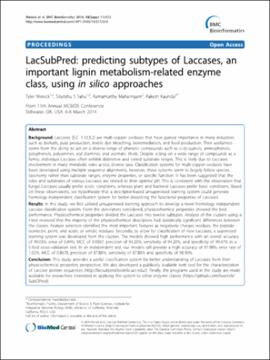| dc.contributor.author | Weirick, Tyler | |
| dc.contributor.author | Sahu, Sitanshu S. | |
| dc.contributor.author | Mahalingam, Ramamurthy | |
| dc.contributor.author | Kaundal, Rakesh | |
| dc.date.accessioned | 2018-11-09T21:11:00Z | |
| dc.date.available | 2018-11-09T21:11:00Z | |
| dc.date.issued | 2014-10-21 | |
| dc.identifier | oksd_weirick_lacsubpredpre_2014 | |
| dc.identifier.citation | Weirick, T., Sahu, S. S., Mahalingam, R., & Kaundal, R. (2014). LacSubPred: Predicting subtypes of Laccases, an important lignin metabolism-related enzyme class, using in silico approaches. BMC Bioinformatics, 15(Suppl 11), Article S15. https://doi.org/10.1186/1471-2105-15-S11-S15 | |
| dc.identifier.uri | https://hdl.handle.net/11244/302081 | |
| dc.description.abstract | Background: Laccases (E.C. 1.10.3.2) are multi-copper oxidases that have gained importance in many industries such as biofuels, pulp production, textile dye bleaching, bioremediation, and food production. Their usefulness stems from the ability to act on a diverse range of phenolic compounds such as o-/p-quinols, aminophenols, polyphenols, polyamines, aryl diamines, and aromatic thiols. Despite acting on a wide range of compounds as a family, individual Laccases often exhibit distinctive and varied substrate ranges. This is likely due to Laccases involvement in many metabolic roles across diverse taxa. Classification systems for multi-copper oxidases have been developed using multiple sequence alignments, however, these systems seem to largely follow species taxonomy rather than substrate ranges, enzyme properties, or specific function. It has been suggested that the roles and substrates of various Laccases are related to their optimal pH. This is consistent with the observation that fungal Laccases usually prefer acidic conditions, whereas plant and bacterial Laccases prefer basic conditions. Based on these observations, we hypothesize that a descriptor-based unsupervised learning system could generate homology independent classification system for better describing the functional properties of Laccases. | |
| dc.description.abstract | Results: In this study, we first utilized unsupervised learning approach to develop a novel homology independent Laccase classification system. From the descriptors considered, physicochemical properties showed the best performance. Physicochemical properties divided the Laccases into twelve subtypes. Analysis of the clusters using a t-test revealed that the majority of the physicochemical descriptors had statistically significant differences between the classes. Feature selection identified the most important features as negatively charges residues, the peptide isoelectric point, and acidic or amidic residues. Secondly, to allow for classification of new Laccases, a supervised learning system was developed from the clusters. The models showed high performance with an overall accuracy of 99.03%, error of 0.49%, MCC of 0.9367, precision of 94.20%, sensitivity of 94.20%, and specificity of 99.47% in a 5-fold cross-validation test. In an independent test, our models still provide a high accuracy of 97.98%, error rate of 1.02%, MCC of 0.8678, precision of 87.88%, sensitivity of 87.88% and specificity of 98.90%. | |
| dc.description.abstract | Conclusion: This study provides a useful classification system for better understanding of Laccases from their physicochemical properties perspective. We also developed a publically available web tool for the characterization of Laccase protein sequences (http://lacsubpred.bioinfo.ucr.edu/). Finally, the programs used in the study are made available for researchers interested in applying the system to other enzyme classes (https://github.com/tweirick/SubClPred). | |
| dc.format | application/pdf | |
| dc.language | en_US | |
| dc.publisher | BioMed Central | |
| dc.rights | This material has been previously published. In the Oklahoma State University Library's institutional repository this version is made available through the open access principles and the terms of agreement/consent between the author(s) and the publisher. The permission policy on the use, reproduction or distribution of the material falls under fair use for educational, scholarship, and research purposes. Contact Digital Resources and Discovery Services at lib-dls@okstate.edu or 405-744-9161 for further information. | |
| dc.title | LacSubPred: Predicting subtypes of Laccases, an important lignin metabolism-related enzyme class, using in silico approaches | |
| osu.filename | oksd_weirick_lacsubpredpre_2014.pdf | |
| dc.description.peerreview | Peer reviewed | |
| dc.identifier.doi | 10.1186/1471-2105-15-S11-S15 | |
| dc.description.department | National Institute for Microbial Forensics and Food and Agricultural Biosecurity | |
| dc.description.department | Biochemistry and Molecular Biology | |
| dc.type.genre | Article | |
| dc.type.material | Text | |
| dc.subject.keywords | bioenergy | |
| dc.subject.keywords | lignin degradation | |
| dc.subject.keywords | laccases | |
| dc.subject.keywords | machine learning | |
| dc.subject.keywords | classification | |
| dc.subject.keywords | bioinformatics | |
| dc.subject.keywords | unsupervised learning | |
